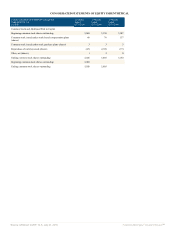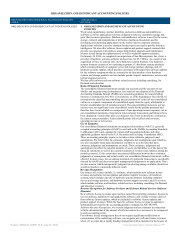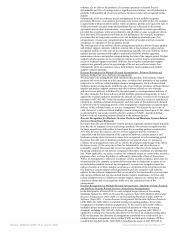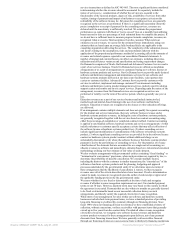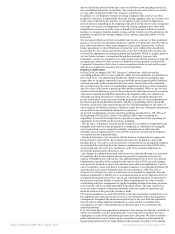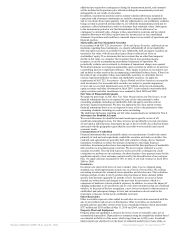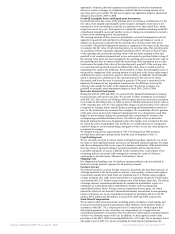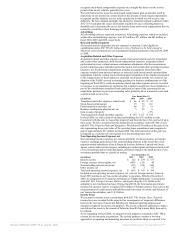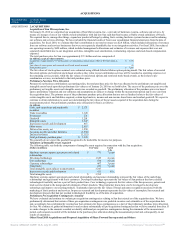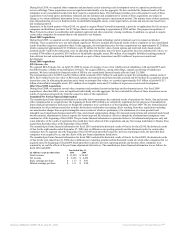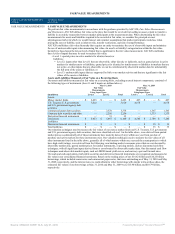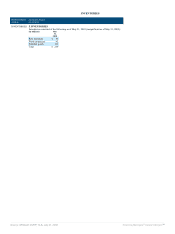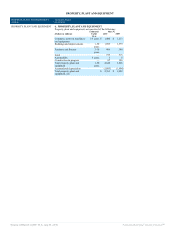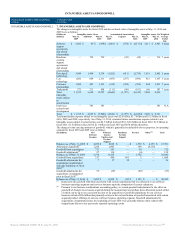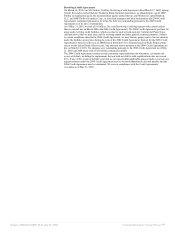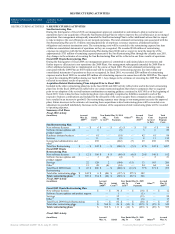Oracle 2009 Annual Report Download - page 194
Download and view the complete annual report
Please find page 194 of the 2009 Oracle annual report below. You can navigate through the pages in the report by either clicking on the pages listed below, or by using the keyword search tool below to find specific information within the annual report.
taken in a tax return. The first step is to determine if the weight of available evidence
indicates that it is more likely than not that the tax position will be sustained in an audit,
including resolution of any related appeals or litigation processes. The second step is to
measure the tax benefit as the largest amount that is more than 50% likely to be realized
upon ultimate settlement. We recognize interest and penalties related to uncertain tax
positions in our provision for income taxes line of our consolidated statements of
operations.
A description of our accounting policies associated with tax related contingencies and
valuation allowances assumed as a part of a business combination is provided under
“Business Combinations” above.
Recent Accounting Pronouncements
Milestone Method of Revenue Recognition: In April 2010, the FASB issued Accounting
Standards Update No. 2010-17, Revenue Recognition—Milestone Method (Topic 605) -
Revenue Recognition (ASU 2010-17). ASU 2010-17 provides guidance on defining the
milestone and determining when the use of the milestone method of revenue recognition
for research or development transactions is appropriate. It provides criteria for evaluating
if the milestone is substantive and clarifies that a vendor can recognize consideration that
is contingent upon achievement of a milestone as revenue in the period in which the
milestone is achieved, if the milestone meets all the criteria to be considered substantive.
ASU 2010-17 is effective for us in fiscal 2012 and should be applied prospectively. Early
adoption is permitted. If we were to adopt ASU 2010-17 prior to the first quarter of fiscal
2012, we must apply it retrospectively to the beginning of the fiscal year of adoption and
to all interim periods presented. We are currently evaluating the impact of the pending
adoption of ASU 2010-17 on our consolidated financial statements.
Disclosure Requirements Related to Fair Value Measurements: In January 2010, the
FASB issued Accounting Standards Update No. 2010-06, Improving Disclosures about
Fair Value Measurements (Topic 820)—Fair Value Measurements and Disclosures
(ASU 2010-06), to add additional disclosures about the different classes of assets and
liabilities measured at fair value, the valuation techniques and inputs used, the activity in
Level 3 fair value measurements, and the transfers between Levels 1, 2, and 3 (as defined
in Note 4 below). Certain provisions of this update will be effective for us in fiscal 2012
and we are currently evaluating the impact of the pending adoption of this standards
update on our consolidated financial statements.
Transfers of Financial Assets: In June 2009, the FASB issued and subsequently codified
Accounting Standards Update No. 2009-16, Transfers and Servicing (Topic
860)—Accounting for Transfers of Financial Assets (ASU 2009-16). ASU 2009-16
eliminates the concept of a “qualifying special-purpose entity” with regards to transfer of
financial assets and changes the requirements for derecognizing financial assets. We will
adopt this new accounting standards update in fiscal 2011 and are currently evaluating the
impact of its pending adoption on our consolidated financial statements.
Variable Interest Entities: In June 2009, the FASB issued and subsequently codified
Accounting Standards Update No. 2009-17, Consolidations (Topic 810)—Improvements
to Financial Reporting by Enterprises Involved with Variable Interest Entities (ASU
2009-17). ASU 2009-17 amends the evaluation criteria to identify the primary beneficiary
of a variable interest entity as provided pursuant to existing accounting standards and
requires ongoing reassessments of whether an enterprise is the primary beneficiary of the
variable interest entity. We will adopt ASU 2009-17 in fiscal 2011 and are currently
evaluating the impact of its pending adoption on our consolidated financial statements.
Source: ORACLE CORP, 10-K, July 01, 2010 Powered by Morningstar® Document Research℠



